Common Insects in
the Charlotte Region
Acrobat Ant
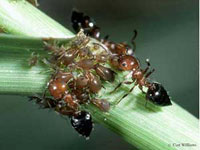
The Acrobat Ant, Crematogaster ashmeadi, is a medium-sized, mostly shiny ant with heart shaped abdomen that is often bent up over the thorax when ant is disturbed. Color variable from light reddish brown to brown or black. Slow to moderately fast moving ant. May forage in tight foraging trails similar to white-footed ant trails, but only acrobat ant bends the abdomen up over the thorax. Acrobat ants also run slower than white-footed ants when disturbed.
The Acrobat Ant is an arboreal ant, nesting in branches and stems and other cavities of trees and shrubs, rotten logs and stumps. In houses they will nest in damaged wood of porches, eaves, etc. Single queen per nest, but colonies occupy multiple nest sites. These ants are uncommon indoors and control should focus on limiting their access to structures.
American Grass Spider
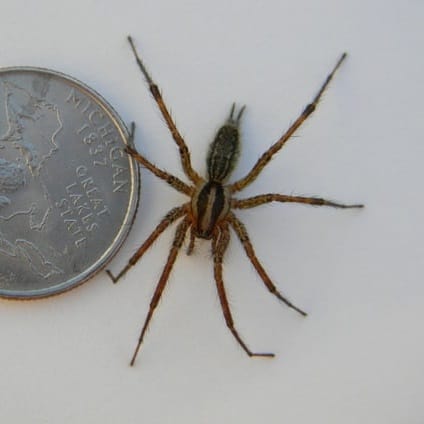
Agelenopsis, American grass spiders, are a genus of spiders that can be found around the world and in every US state. They are some of the fastest spiders in the United States and can be fun just to watch if you can trigger the web right.
Using a long piece of a weed or grass, try tickling the web as a bug would, if it was struggling across the web. If you do it right, the Grass Spider will run out with lightning speed, looking for a meal.
The grass spider is often confused with some similar looking species of the wolf spider or the American Nursery web spider. In the Pacific Northwest, the grass spider’s distribution overlaps with the related hobo spider (Eratigena agrestis) and the giant house spider (Eratigena atrica). Source: usaspiders.com
Bald Face Hornet
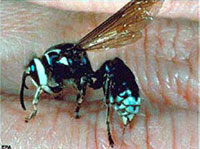 This atypically large black-and-white yellowjacket gets its common name of baldfaced from its largely black color but mostly white face, and that of hornet because of its large size and aerial nest. Baldfaced hornets are found throughout the United States.
This atypically large black-and-white yellowjacket gets its common name of baldfaced from its largely black color but mostly white face, and that of hornet because of its large size and aerial nest. Baldfaced hornets are found throughout the United States.
Adult workers about 5/8 – 3/4+” (15-20+ mm) long; queens about 3/4+” (20+ mm). Color black with white pattern on most of face, as 2 angled stripes on thorax towards head, and on last 3 abdominal segments. Head with clypeus (upper lip) broadly truncate, slightly notched at apex. Hind wing without a jugal lobe (lobe on rear near body). Pronotum in lateral view almost triangula, extending to teguls (structure at base of front wing) or nearly so. Middle tibia with 2 apical spurs. Builds paper enclosed aerial nest, grey in color.
Bald face Hornet Nest
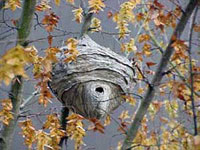 The overwintering queen selects the nest site. This can vary from shrubs or vines at ground level to 66 ft (20 m) or higher in trees. Nests also may be built on overhangs, utility poles, houses, sheds, or other structures. Nearly all nests are constructed in exposed locations. At maturity, the nests can be quite impressive with sizes of up to 14″ (35 cm) in diameter and over 24″ (60+ cm) in length.
The overwintering queen selects the nest site. This can vary from shrubs or vines at ground level to 66 ft (20 m) or higher in trees. Nests also may be built on overhangs, utility poles, houses, sheds, or other structures. Nearly all nests are constructed in exposed locations. At maturity, the nests can be quite impressive with sizes of up to 14″ (35 cm) in diameter and over 24″ (60+ cm) in length.
Often nests located in vegatation are not discovered until the leaves fall in the autumn. Nests are not reused the next season.
Black and Yellow Garden Spider
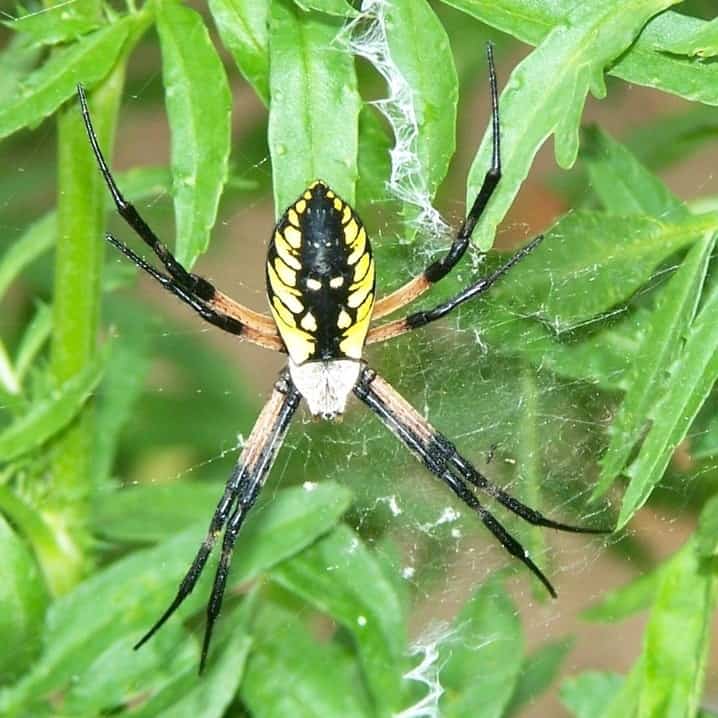
The Argiope Aurantia or black and yellow garden spider appears in every US state and in many other countries around the world. It is characterized by its black and yellow abdomen and a beautifully patterned web. Argiopes are Orb Weavers, but due to their differences from other Orb Weavers, they are often put into their own group.
The Argiope bite is not dangerous to humans. The worst bites will cause some mild localized pain, itchiness, and swelling that will fade in a few days. Most bites will not even be that bad. Source: usaspiders.com
Black Widow Spider
 Latrodectus mactans, the (southern) Black widow, are well known for the distinctive black and red coloring of the female of the species and for the fact that she will occasionally eat her mate after reproduction. The highly venomous species is native to the United States of America. The female black widow’s venom is particularly harmful to humans (males almost never bite humans). The injection of venom from these species is a comparatively dangerous or lethal bite.
Latrodectus mactans, the (southern) Black widow, are well known for the distinctive black and red coloring of the female of the species and for the fact that she will occasionally eat her mate after reproduction. The highly venomous species is native to the United States of America. The female black widow’s venom is particularly harmful to humans (males almost never bite humans). The injection of venom from these species is a comparatively dangerous or lethal bite.
Black widow spiders are nocturnal and, thus, are active at night. They prefer dark corners or crevices. They are said to avoid human dwellings, but you can find them in such areas as outhouses and garages. Only the female black widow bites humans, and she bites only when disturbed, usually while protecting her eggs.
Boxelder Bug
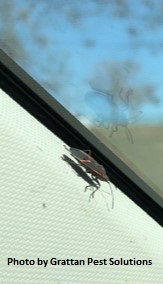 Boxelder bugs, Boisea (Leptocores) trivittata, are eliptical and about a half inch long. their body is either dark gray or black and have 3 red strips on the thorax. The female lays around 250 eggs at a time. when the Nymphs hatch they are bright red. The boxelder bug increases it's population around July to early September each year. Boxelder bugs do not bite or harm items around your home. They feed on the seeds of boxelder trees and sometimes ash and and maple trees. Their presence in our human world are just a nuisance. You may see them on winter days coming out of their over wintering locations to enjoy the sunshine of a warm day! They normally do not come inside your home. Most people find if they are inside, it is because there is an opening in a door or window.
Boxelder bugs, Boisea (Leptocores) trivittata, are eliptical and about a half inch long. their body is either dark gray or black and have 3 red strips on the thorax. The female lays around 250 eggs at a time. when the Nymphs hatch they are bright red. The boxelder bug increases it's population around July to early September each year. Boxelder bugs do not bite or harm items around your home. They feed on the seeds of boxelder trees and sometimes ash and and maple trees. Their presence in our human world are just a nuisance. You may see them on winter days coming out of their over wintering locations to enjoy the sunshine of a warm day! They normally do not come inside your home. Most people find if they are inside, it is because there is an opening in a door or window.
Brown Recluse Spider
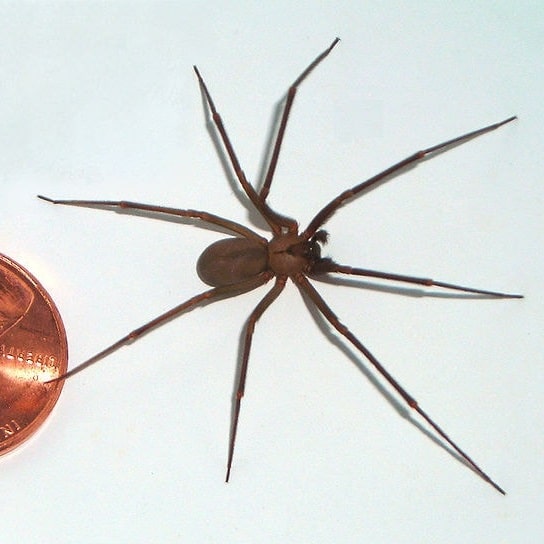
The brown recluse, loxosceles reclusa, is one of the more dangerous spiders indigenous in the United States. While usually not life-threatening, a brown recluse bite might lead to severe skin damage. This page gives an overview of how to identify a brown recluse and in which states in the US it appears.
The Brown Recluse does NOT have spiny hairs on the legs, spots or stripes on the legs or abdomen, any bright colors, or short fat legs. If you see a spider with any of these, it is not the Brown Recluse.
Usually, the Brown recluse does not spin much of a web. It is not like many spiders that uses their web to catch prey, instead, it wanders out at night to hunt its prey. When it does spin a web, it is usually to nest and lay eggs. The web is small, sometimes as little as an inch across and looks to be randomly built with no design.
The recluse is not prone to biting. It is not an aggressive spider at all. When it does bite, it is almost always due to someone pressing against one and it is forced to bite to defend itself. In cases where it does bite, the recluse will often administer a dry bite that is virtually harmless. If it does use venom, it is often that the venom will not have much of an effect. However, there are those bites when the venom does have a serious effect. Its venom is a cytotoxin which will break down the tissue around the bite, causing a wound that looks as if the flesh is rotting. This wound will usually grow to around 3 or 4 inches across. Source: usaspiders.com
Carpenter Ant
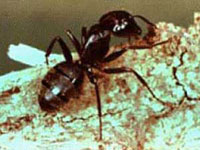 The most likely species to be infesting a house in the United States is the Black carpenter ant. They prefer dead, damp wood in which to build nests. Sometimes carpenter ants will hollow out sections of trees.
The most likely species to be infesting a house in the United States is the Black carpenter ant. They prefer dead, damp wood in which to build nests. Sometimes carpenter ants will hollow out sections of trees.
The Carpenter Ant resides both outdoors and indoors in moist, decaying or hollow wood. They cut “galleries” into the wood grain to provide passageways for movement from section to section of the nest. They can leave “sawdust” behind that provides clues to nesting location. If this wooden complex happens to be a wall frame within your home, structural damage may result. Moisture is the key component to look for when managing this species.
Carpet Beetle
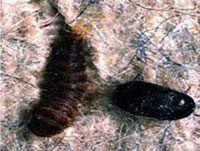 The black carpet beetle, Attagenus megatoma, is a widely known stored product pest and one of the most destructive because the damage caused to household products containing keratin, which is a protein found in animal hair and feathers.[11][19] They are also able to burrow through various food packaging allowing passage for other insects as well.
The black carpet beetle, Attagenus megatoma, is a widely known stored product pest and one of the most destructive because the damage caused to household products containing keratin, which is a protein found in animal hair and feathers.[11][19] They are also able to burrow through various food packaging allowing passage for other insects as well.
The varied carpet beetle, Anthrenus verbasci, attacks typical household objects. Carpet beetles are normally associated with things such as carpets, wool, furs, and any processed animal or plant food. Their appetite also includes dead insects, spiders, and even nectar and pollen.
Casemaking Clothes Moth
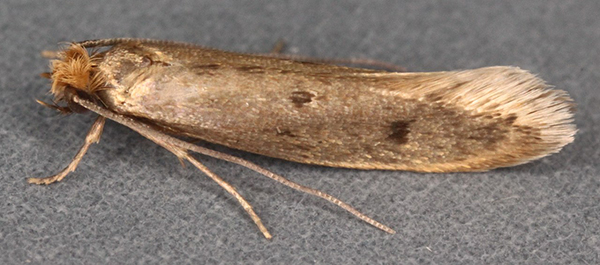 The casemaking or case-bearing clothes moth is a member of the fungus moth family. It has a cosmopolitan distribution and is often referred to as a bagworm because of the bags that the larva carry themselves around in. It is a common pest to upholstery, woolen fabric, fur, and carpet, as evident from its name. source: mothindentification.com
The casemaking or case-bearing clothes moth is a member of the fungus moth family. It has a cosmopolitan distribution and is often referred to as a bagworm because of the bags that the larva carry themselves around in. It is a common pest to upholstery, woolen fabric, fur, and carpet, as evident from its name. source: mothindentification.com
Cicada Killer Wasps
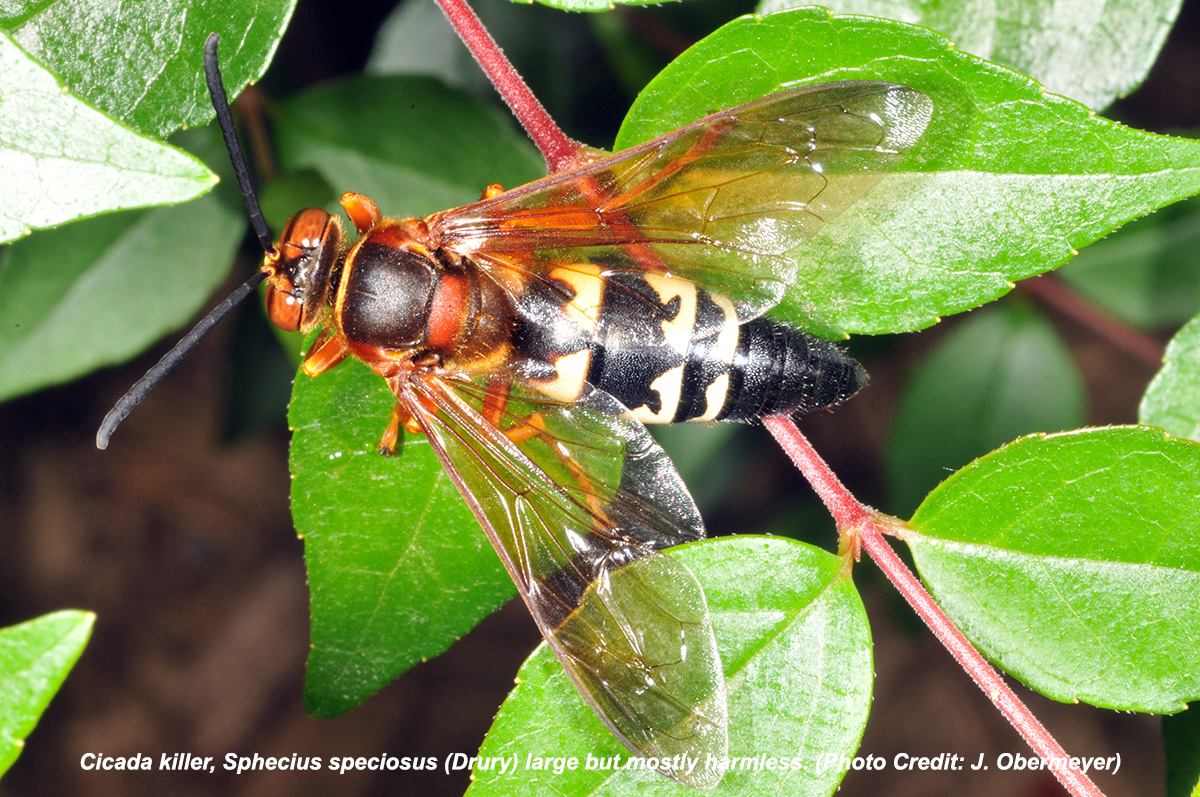 Cicada killers are large, ominous looking wasps that evoke a good deal of fear among people. They look like a giant hornet or huge yellow-jacket and are somewhat aggressive. However, the cicada killer is a solitary wasp, not a social wasp, and as such is not likely to sting unless directly handled. Most of the wasps seen are males that patrol the nesting area. They may fly about people, dive bomb, or even hover in front of faces, but because they are males they cannot sting. Females do not defend their burrows, and will sting only if mishandled.
Cicada killers are large, ominous looking wasps that evoke a good deal of fear among people. They look like a giant hornet or huge yellow-jacket and are somewhat aggressive. However, the cicada killer is a solitary wasp, not a social wasp, and as such is not likely to sting unless directly handled. Most of the wasps seen are males that patrol the nesting area. They may fly about people, dive bomb, or even hover in front of faces, but because they are males they cannot sting. Females do not defend their burrows, and will sting only if mishandled.
Cicada killer wasps may nest in aggregations (several nests in the same area) but do not live together socially as do social bees and wasps. Such aggregations may contain from a few to a hundred or so individual burrows, and may persist for several years in the same location.
A large nesting aggregation sometimes results in unsightly mounds of soil that are the remains of the tunnel excavation. Otherwise, cicada killers do very little damage. Source: extension.entm.purdue.edu
Clothes Moth
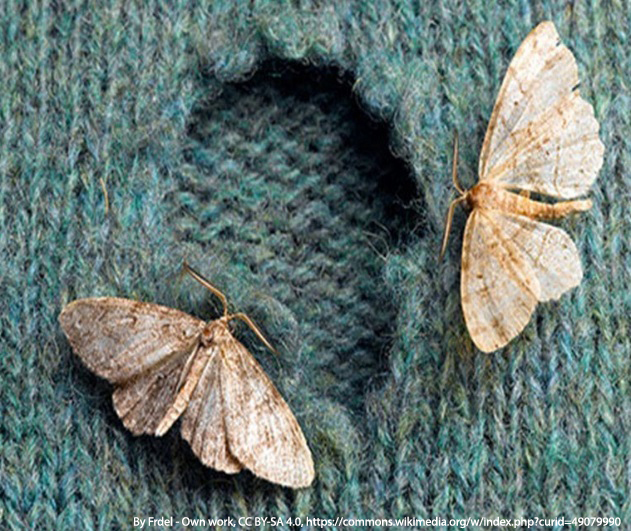 Clothes moth or clothing moth is the common name for several species of moth considered to be pests, whose larvae eat animal fibers (hairs), including clothing and other fabrics.
Clothes moth or clothing moth is the common name for several species of moth considered to be pests, whose larvae eat animal fibers (hairs), including clothing and other fabrics.
The larvae of clothes moths can eat animal fibers which are not removed by other scavengers, and are capable of consuming and digesting keratin materials that make up silk, wool, fur, and hair. This allows clothes moths to attack human-made garments and textiles which include animal fibers, damaging them and leading to the common name of these pests.
Household-wide infestations can stem from a single textile item, such as a garment or rug, with potential targets besides garments including upholstery, toys, or even taxidermied animals. Discarded fibers found around the home can contribute to infestations as well, such as pet sheddings, hair and fur buildup inside vents and air ducts, or birds' nests built inside some part of a house. Basements and attics are commonly the most heavily affected areas. Larvae can also sometimes act as bookworms, chewing through paper (which they cannot digest for nutrition) to reach book bindings or mold colonies for nourishment. Source: Wikipedia
Fire Ant
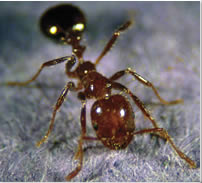 Originally from South America. Fire Ants are Red or yellowish ants of small-to-medium size with a severe sting that burns. They normally feed on small insects but, with denser populations, they eat seeds and seedling plants, damage grain and vegetable crops, invade kitchens, attack newly hatched poultry and the young of ground-nesting wild birds.
Originally from South America. Fire Ants are Red or yellowish ants of small-to-medium size with a severe sting that burns. They normally feed on small insects but, with denser populations, they eat seeds and seedling plants, damage grain and vegetable crops, invade kitchens, attack newly hatched poultry and the young of ground-nesting wild birds.
Fire ants can kill newborn domestic and wild animals. Each colony is composed of a queen, winged males and females and 3 kinds of workers. A nest averages about 25,000 workers, but far larger populations are common.
Semi permanent nests are large mounds of excavated soil with openings for ventilation. Since nests may number 50-100 (or more) in a heavily infested field, cultivating becomes difficult (or impossible). Fire ants belong to the genus Solenopsis. The severe sting of this ant causes a pustule to form within 24 hours that takes 10-14 days to resolve. Fire ant toxin can trigger an allergic reaction, particularly in people allergic to bee, wasp and yellow jacket stings.
Avoidance and prompt treatment are essential.
Firebrat
 The Firebrat is a small insect (typically 1-1.5 cm) similar to the Silverfish, both in the order Thysanura.
The Firebrat is a small insect (typically 1-1.5 cm) similar to the Silverfish, both in the order Thysanura.
Firebrats prefer higher temperatures and require some humidity, and can be found in bakeries and near boilers or furnaces. They feed on a wide variety of carbohydrates and starches that are also protein sources such as flour and book bindings, and can go for as much as a year without eating. They are distributed throughout most parts of the world and are normally found outdoors under rocks, leaf litter, and similar, but are also often found indoors where they are considered pests. They are primarily a nuisance inside the home or buildings, as they do not cause major damage, though they can contaminate food, damage paper goods, and stain clothing. Otherwise they are mostly harmless.
Formosan Termites
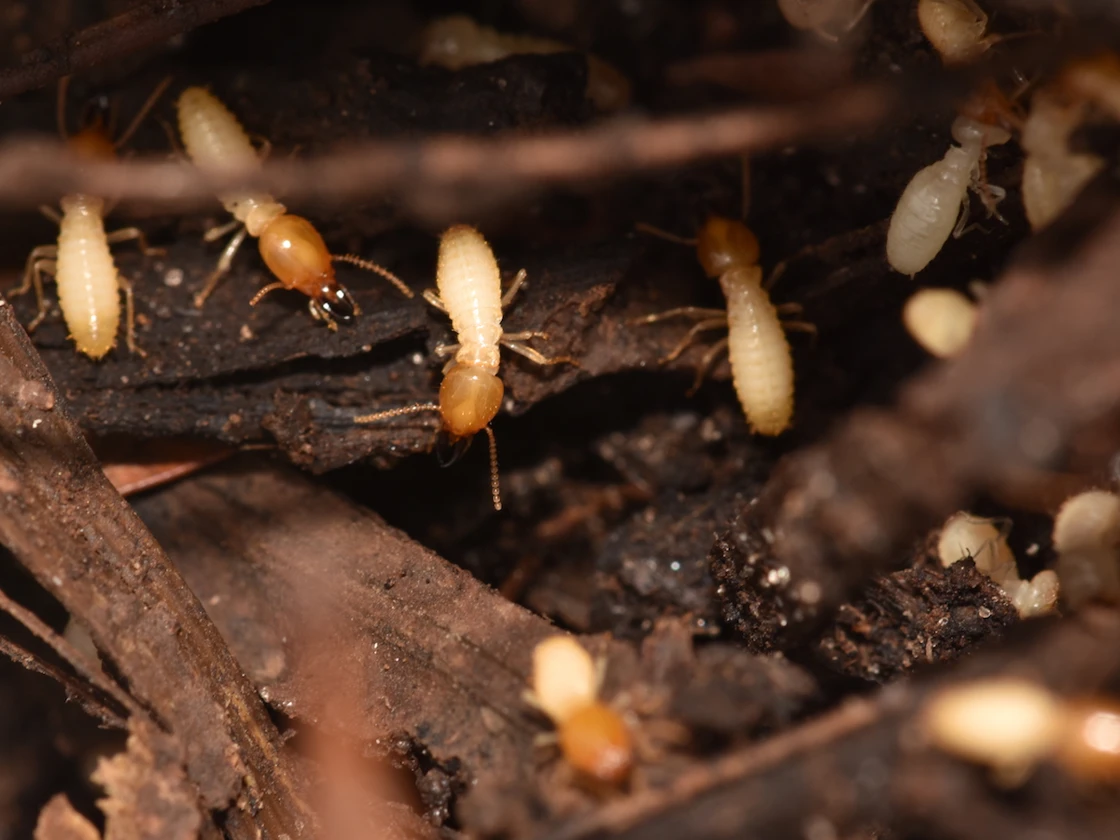 Formosan termites are a subterranean species of termite with three distinct castes: alates (or reproductive), soldiers and workers. Often referred to as “super termites,” they are the most voracious, aggressive and devious of over 2,000 termite species known to science, chewing through wood, flooring and even wallpaper undetected.
Formosan termites are a subterranean species of termite with three distinct castes: alates (or reproductive), soldiers and workers. Often referred to as “super termites,” they are the most voracious, aggressive and devious of over 2,000 termite species known to science, chewing through wood, flooring and even wallpaper undetected.
Another sign of a Formosan termite infestation is damaged wood that sounds hollow when tapped. The wood often appears to have been eaten away along the grain pattern.
There are a few red flags signaling a Formosan termite problem. The first sign that an area is infested with Formosans is the presence of swarmers, or winged reproductives. Swarmers are often attracted to lights, so homeowners should keep an eye out for them (and their discarded wings) near windowsills, doors, lights and vents. Source: pestworld.org
German Cockroach
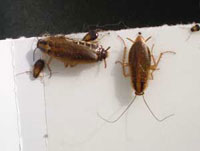 The German cockroach, Croton bug or Steam fly (Blattella germanica) is a small species of cockroach, measuring about 1.3 cm (0.51 in) to 1.6 cm (0.63 in) long. It can be tan through brown to almost black, and has two dark parallel streaks running from the head to the base of the wings. Although it has wings, it is unable to sustain flight. The German cockroach is one of the most common and prominent household cockroaches in the world, and can be found throughout many human settlements. These insects are particularly fond of inhabiting restaurants, food processing facilities, hotels, and nursing homes.
The German cockroach, Croton bug or Steam fly (Blattella germanica) is a small species of cockroach, measuring about 1.3 cm (0.51 in) to 1.6 cm (0.63 in) long. It can be tan through brown to almost black, and has two dark parallel streaks running from the head to the base of the wings. Although it has wings, it is unable to sustain flight. The German cockroach is one of the most common and prominent household cockroaches in the world, and can be found throughout many human settlements. These insects are particularly fond of inhabiting restaurants, food processing facilities, hotels, and nursing homes.
The German cockroach is very successful at establishing an ecological niche in buildings, and is very hardy and resilient against attempts at pest control. This cockroach is also smaller than many other species so it can more easily hide and fit into very small cracks and crevices to evade humans. That is also the main reason they can most effectively be controlled with bait in cracks and crevices near harborages. These type of pest control methods should kill 95% of the overall population in a property due to their fast reproductive cycles.
House Spider
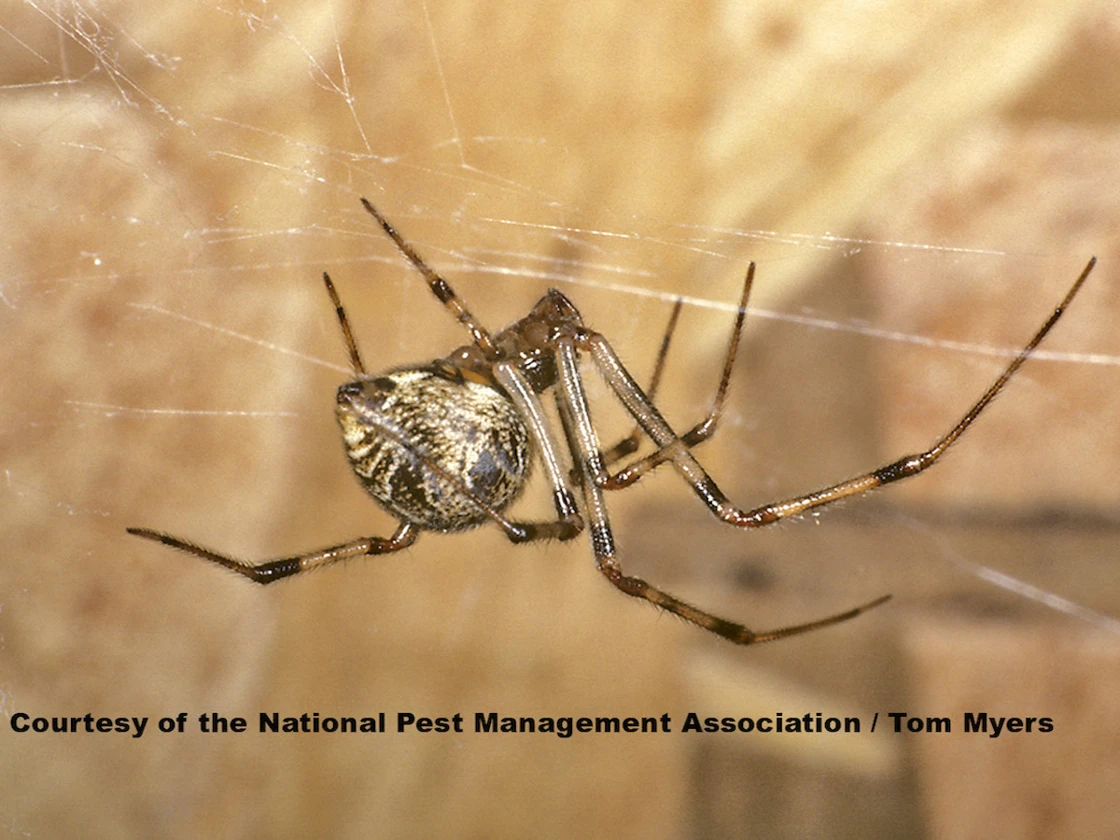
The common house spider gets its name from the fact that it is usually the spider most often encountered indoors. It is a nuisance pest, probably more because of its webs than the spider itself. The house spider is found worldwide and is common throughout the United States and Canada. Read on to learn more information, including advice on house spider control.
The common house spider randomly selects its web sites and creates a tangled web. If a web does not yield prey (food) it is abandoned, another site is selected, and a new web built. Eventually, successful webs are constructed where air currents bring in prey. House spiders have a difficult time surviving in modern homes due to low humidity and fewer insects for food. They are more likely to be found inside structures like garages, sheds, barns and warehouses. Outside, these domestic spiders are often around windows and under eaves, especially near light sources that attract prey.
Inside structures, house spiders are most likely to be found in upper corners, under furniture, in closets, angles of window frames, basements, garages, and crawl spaces. In warehouses, they are common in corners near doors that stay open. Because of their web site selection by trial and error, many house spider webs may be constructed in several days. Dust collecting on these webs accentuates their presence.
House spiders are not known to bite but may do so in threatening situations, such as when they are being crushed. While house spider bites are typically not medically threatening, it is important to seek medical attention in the event of severe swelling, lesions or headaches. Source: pestworld.org
Indian Meal Moths
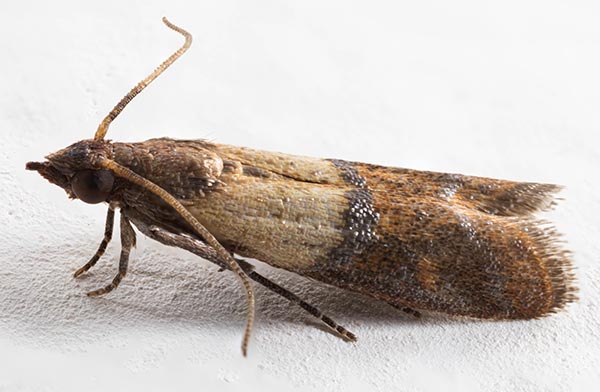 The Indian meal moth was given its name after an insect scientist found it feeding on corn meal, also known as Indian meal. From wing tip to wing tip, adult moths measure from five-eighths of an inch to three-fourths of an inch long.
The Indian meal moth was given its name after an insect scientist found it feeding on corn meal, also known as Indian meal. From wing tip to wing tip, adult moths measure from five-eighths of an inch to three-fourths of an inch long.
Indian meal moths like to feed on dried fruits, grains, seeds, nuts, chocolate, candies, bird seed, dog food, powdered milk, dried red peppers and candy. Attracted to the light, these bugs are found worldwide in areas where food is stored, such as grocery stores. Indian meal moths infest foods and can contaminate food products. Source: pestworld.org
Mud Dauber Wasps

Mud dauber is a common name for a wasp that constructs its nest of mud. There are many species of wasps referred to as mud daubers, such as organ pipe mud daubers, black-and-yellow mud daubers and blue mud daubers. If you’ve ever wondered, “do mud daubers sting,” you’re not alone — mud daubers are very common and found throughout the United States, and most don’t know much about them except that they look nasty. Read on to learn more about whether mud daubers stings, and how to get rid of mud daubers.
Female mud daubers construct nests of mud. Many short mud tubes, usually about 1" long, are constructed side by side. They usually build their nests in a sheltered site, such as under eaves, porch ceilings, in garages and sheds left open, in barns and attics, etc. Nests typically exhibit round holes in them as the wasps emerge. This means the nest is probably old and inactive after springtime. Typical mud dauber nest locations include sheltered sites under eaves, porch ceilings, open garages or sheds, barns, protected building walls and attics.
Mud daubers are not aggressive and are unlikely to sting. Still, care should be taken in the presence of an abandoned mud dauber nest, as other, more aggressive insects may take it over. Source: petworld.org
Odorous House Ants
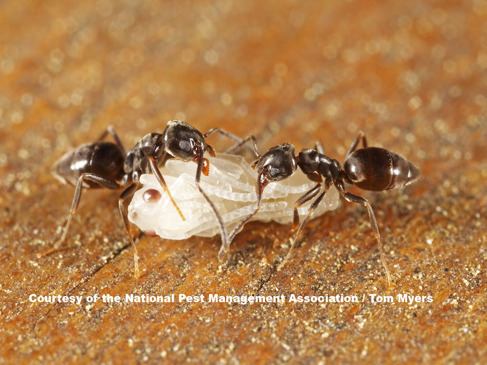
The odorous house ant gets its name from the strong, rotten coconut-like smell it gives off when crushed. These tiny brown ants range in size from one-sixteenth of an inch to one-eighth of an inch long.
Odorous house ants like to eat sweets and are especially fond of honeydew. They are known to move their nests every three months or so in response to rain. Indoors, odorous house ants nest near moisture sources, such as in wall voids near hot water pipers, in heaters, beneath leaky fixtures and inside wood damaged by termites. Outside, odorous ants are often found in exposed soil or under stacks of firewood. Source: pestworld.org
Paper Wasps
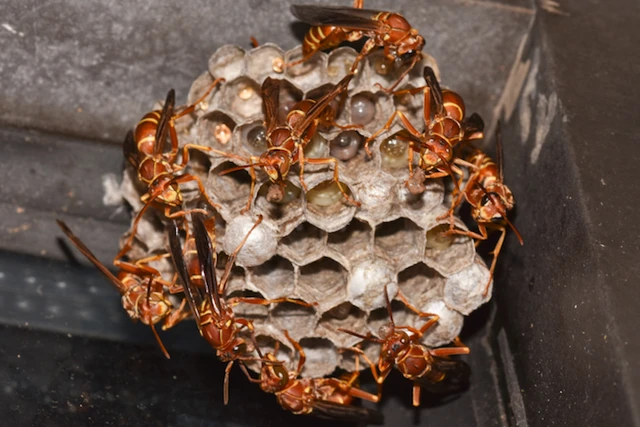
Paper wasps get their common name from the paper-like material out of which they make their nests. Paper wasps are sometimes called umbrella wasps, after the shape of their distinctive nests. Paper wasps eat nectar and other insects including caterpillars and flies. In the autumn, future queens will seek places to spend the winter and may find their way indoors.
While not an aggressive species by nature, paper wasps will sting if they are disturbed or their nest is threatened. It’s unusual for an impregnated paper wasp to sting, but it can happen.
Then, in the springtime, they will emerge to build their umbrella-shaped nests that look as though they are made of paper. Paper wasps build their comb nests to hang from objects like twigs and branches of trees and shrubs, porch ceilings, the tops of window and doorframes, soffits, eaves, attic rafters, deck floor joists, railings and more. Each nest has open, uncovered cells where the eggs are laid. Other females will help build future nests, and only the one queen will lay eggs for the colony. Once that queen dies, a new egg-laying female will take her place. Source: petworld.org
Pavement Ants
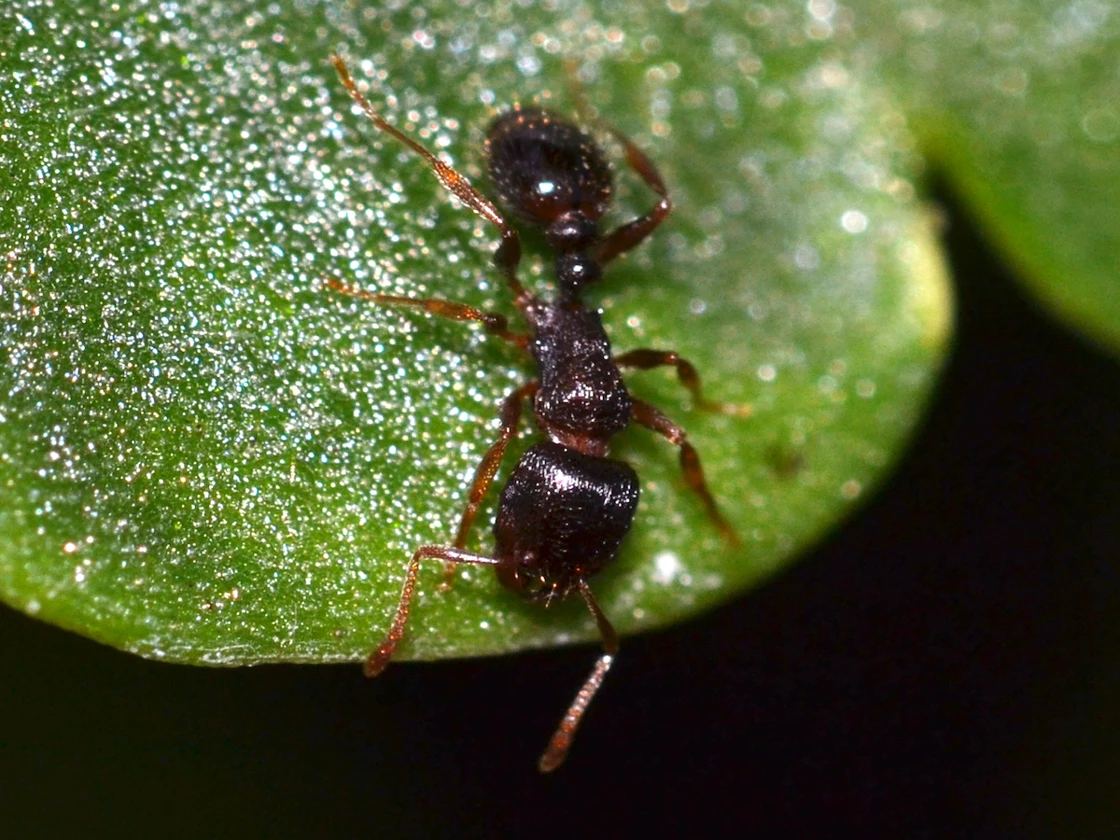
Pavement ants get their name because they make nests in or under cracks in pavement. These dark brown to black ants can also infest structures.
These black ants will eat almost anything. Pavement ants have been known to consume insects, seeds, honeydew, honey, bread, meats, nuts and cheese. They forage in trails for distances of up to 30 feet and are known to climb masonry walls that enter into occupied areas.
In buildings, pavement ants are most likely to be found in ground-level masonry walls, but they also nest in walls, insulation and under floors. Outside, these black ants typically nest under stones, pavement cracks and next to buildings. Source: petworld.org
Powderpost Beetles
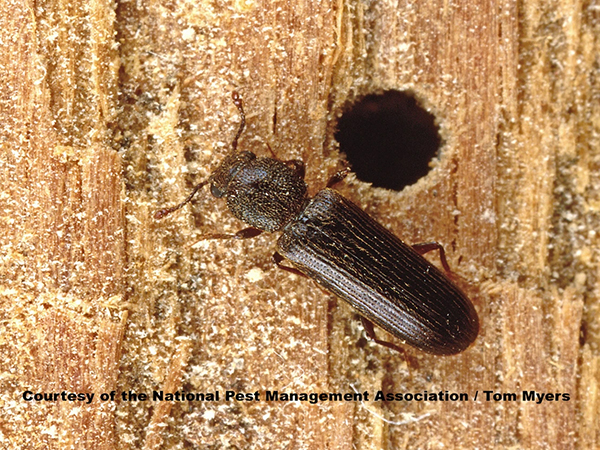
Powderpost beetles lay their eggs in cracks of wood and the larvae tunnel into the surface, filling it with a very fine powder-like dust. Powderpost beetles have long, narrow, flat bodies that allow them to easily attack wood surfaces. These beetles are reddish-brown in color.
Adult powderpost beetles are very active at night, enjoy flying and are attracted to the light. Powderpost beetles often attack hardwoods, and can be found in hardwood floors, timbers and crates, antiques and other objects made of hardwood materials. Some researchers believe that powderpost beetles are second only to termites in the United States in their destructiveness to wood and wood products. Source: pestworld.org
Silverfish
 The Silverfish is a small, wingless insect typically measuring from a half to one inch
The Silverfish is a small, wingless insect typically measuring from a half to one inch
(12-25 mm). Its common name derives from the animal’s silvery blue color, combined with the fish-like appearance of its movements
The favorite food of silverfish is any matter that contains starch or polysaccharides, such as dextrin in adhesives. These include glue, book bindings, paper, photos, sugar, hair, and dandruff. Silverfish can also cause damage to books, tapestries, and textiles. Silverfish will commonly graze in and around showers, baths, and sinks on the cellulose present in many shampoos, shaving foams and so on. Apart from these cases, the damage caused by silverfish is negligible and they have no direct effect on human health beyond psychological distress to those who are frightened or disgusted by their appearance, or to those whose books have been destroyed by the creatures.
Silverfish can be found anywhere in homes including, but not limited to, garages, closets, underneath beds, couches, and in electrical appliances where food can be found, such as computer keyboards. They generally prefer dark areas.
Stink Bugs
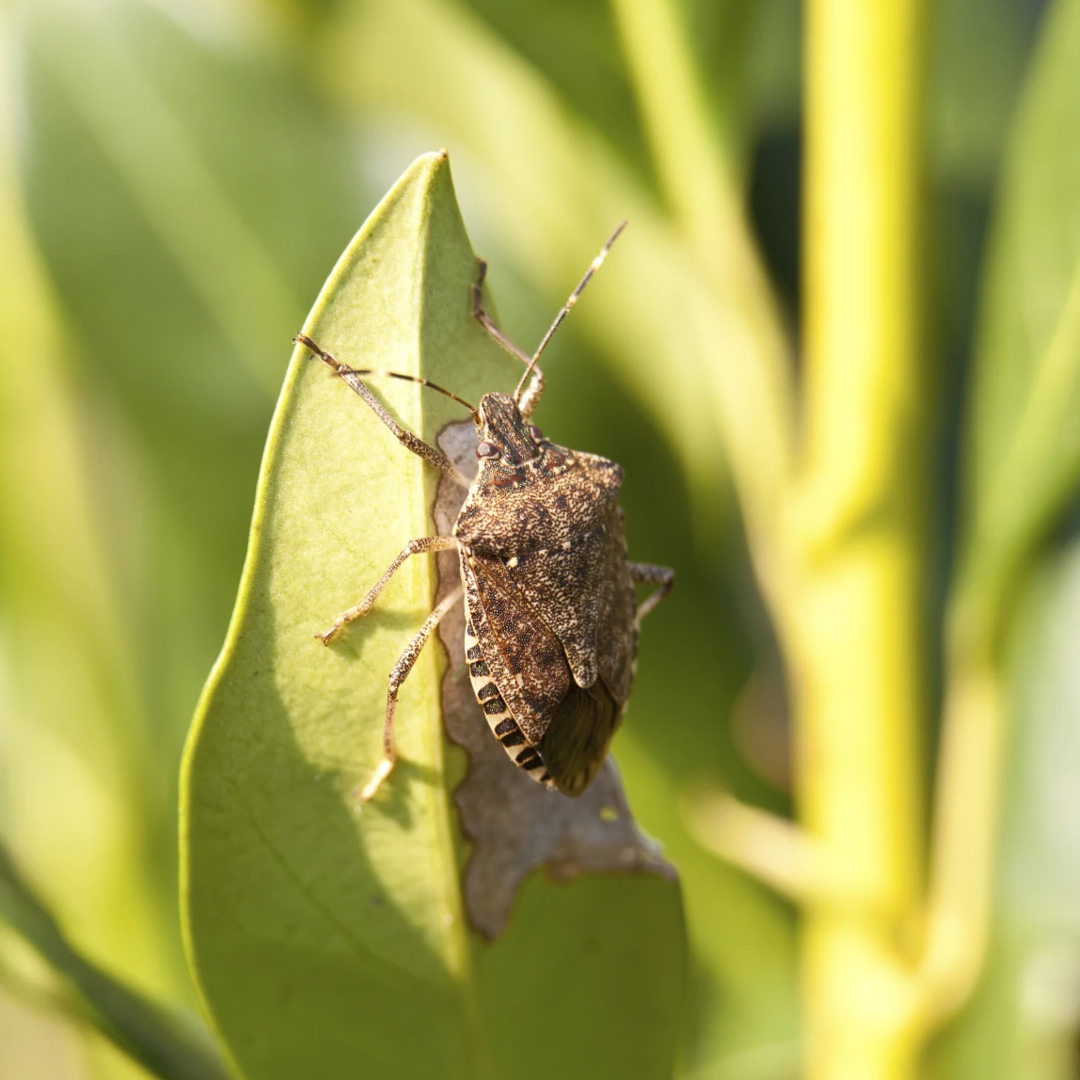 The brown marmorated stink bug (BMSB) earned its name from its tendency to release an odor when disturbed or when crushed. Many other insects have these same characteristics, including some species of ants, beetles and other bugs, but you can recognize a stink bug via its distinctive shape, with a flatter top leading toward a pointed bottom, reminiscent of a shield. Additionally, stink bugs can fly and are pretty good at it!
The brown marmorated stink bug (BMSB) earned its name from its tendency to release an odor when disturbed or when crushed. Many other insects have these same characteristics, including some species of ants, beetles and other bugs, but you can recognize a stink bug via its distinctive shape, with a flatter top leading toward a pointed bottom, reminiscent of a shield. Additionally, stink bugs can fly and are pretty good at it!
Stink bugs were first collected in the United States in Allentown, PA in the fall of 1996, but apparently not recognized or identified until September 2001. They quickly spread east to New Jersey, then Virginia by 2004, and now southward to the North Carolina border. Today, brown marmorated stink bugs are most prevalent in the mid-Atlanta region, but they have been identified in 44 states and the District of Columbia. Read on to learn about stink bugs, including information on identifying a stink bug infestation, and how to get rid of them.
Subterranean Termites
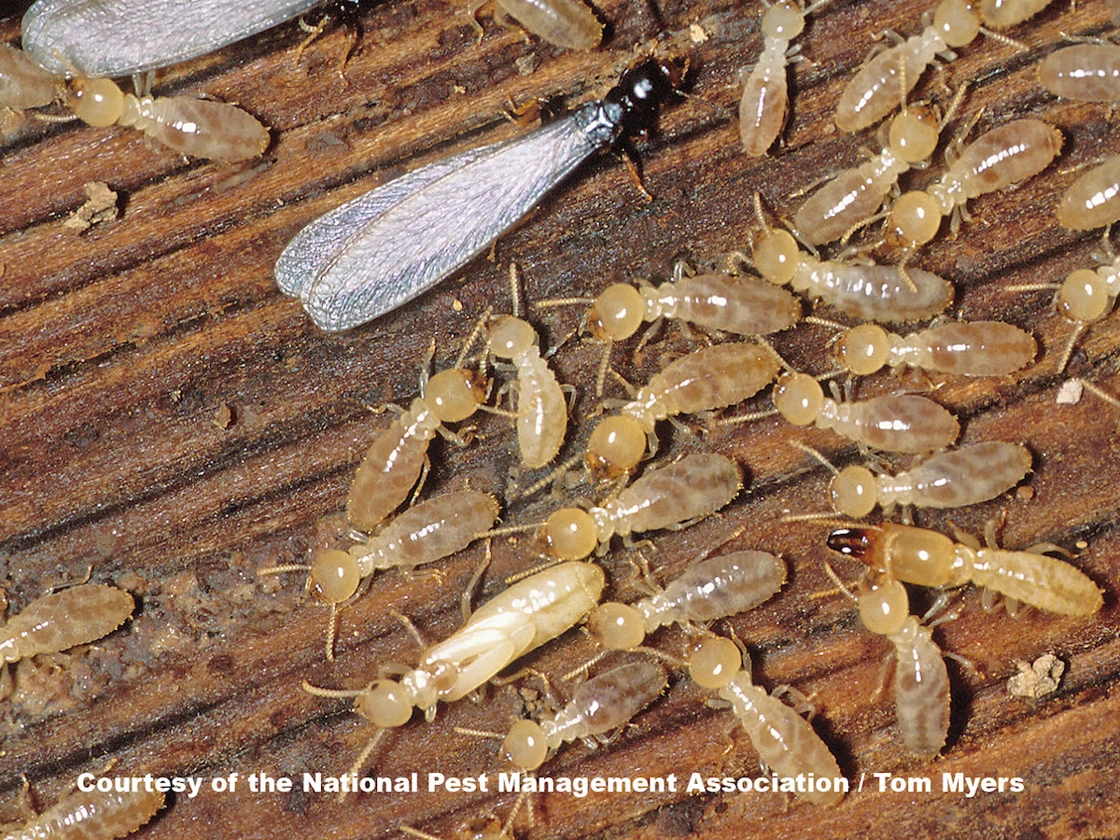 Subterranean termites can cause the most damage of any termite species. These termites build distinctive tunnels, often referred to as “mud tubes,” to reach food sources and protect themselves from open air. They eat wood 24 hours a day, seven days a week, using their saw-toothed jaws to bite off small fragments of wood one piece at a time. Over time, subterranean termites can critically damage a building structure, sometimes causing a total collapse. Subterranean termites threaten homeowners across the country, as they’re found in every state in the U.S except Alaska.
Subterranean termites can cause the most damage of any termite species. These termites build distinctive tunnels, often referred to as “mud tubes,” to reach food sources and protect themselves from open air. They eat wood 24 hours a day, seven days a week, using their saw-toothed jaws to bite off small fragments of wood one piece at a time. Over time, subterranean termites can critically damage a building structure, sometimes causing a total collapse. Subterranean termites threaten homeowners across the country, as they’re found in every state in the U.S except Alaska.
A typical, mature subterranean termite colony can consist of anywhere between 60,000 and two million workers. Subterranean termites use their scissor-like jaws to eat wood 24 hours a day, seven days a week. Like other termite species, subterranean termites also feed on products containing cellulose.
Traveling through their distinctive mud tubes, subterranean termites can enter structures through cracks less than 1/16" (1-2 mm) wide. However, if a constant source of moisture is available, such as leaky pipes, colonies can also exist above the ground. “True aerial” colonies, which have no contact with the ground, are also known to exist. In any given building with a subterranean termite infestation, there may be several colonies co-existing at once.
Subterranean termite infestations can occur on the inside or exterior of the home. There are several telltale signs of a termite infestation. One sign is the presence of mud tubes on the exterior of the home. Mud tubes look like long tunnels made of wood and soil, which the termites construct to protect them from drying out as they travel. Other signs of a subterranean termite infestation include soft wood in the home that sounds hollow when tapped, darkening or blistering of wood structures, uneven or bubbling paint, and small piles of feces that resemble sawdust near a termite nest. Discarded wings near doors or on windowsills also indicate that swarmers have entered and infested the home. Source: pestworld.org
Velvet Ants
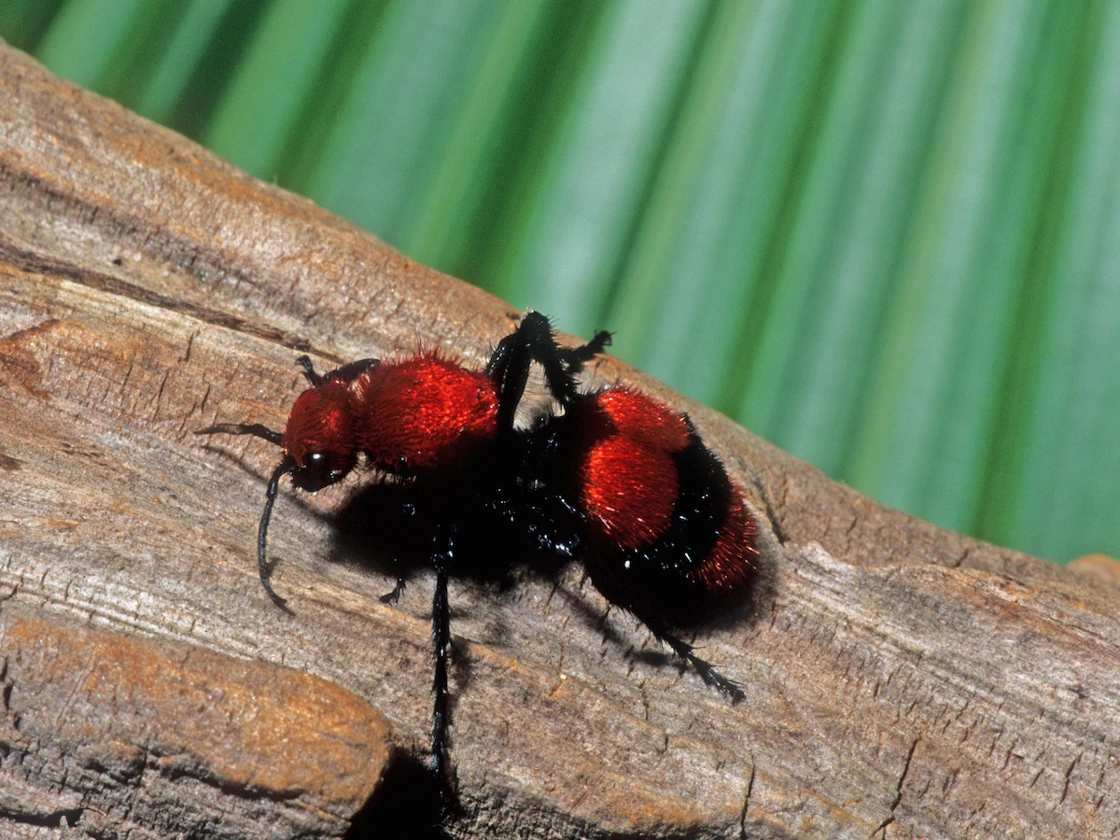
Although commonly referred to as the cow killer ant or red velvet ant, this insect is actually a wasp. They get the "velvet" part of their name from the fuzziness of the females, which are wingless and often brightly colored, appearing like a red and black ant. Velvet ants are typically black, with areas of very bright red, orange, yellow or white. Females are wingless while males have wings.
Female cow killer ants are also typically seen running somewhat erratically on the ground, especially on bare or sandy areas in the warm summer months. These pests will occasionally enter structures for insect prey. Male velvet ants are often found on flowers, although some species are nocturnal. Female cow killer ants dig into the nesting chambers of ground-nesting bees and wasps and lay their eggs on the larvae inside. When the immature velvet ant is born, it eats its host and then spins its cocoon within the pupal case of its host.
Not only do red velvet ants sting, but female red velvet ant stings are very potent and have earned them the nickname "cow killer ant" because of the myth that the sting is so painful it could kill a cow. While the sting is painful, the venom is not very toxic. Like most stinging insects, velvet ants rarely sting unless provoked. Males do not sting. Source: petworld.org
Wolf Spider
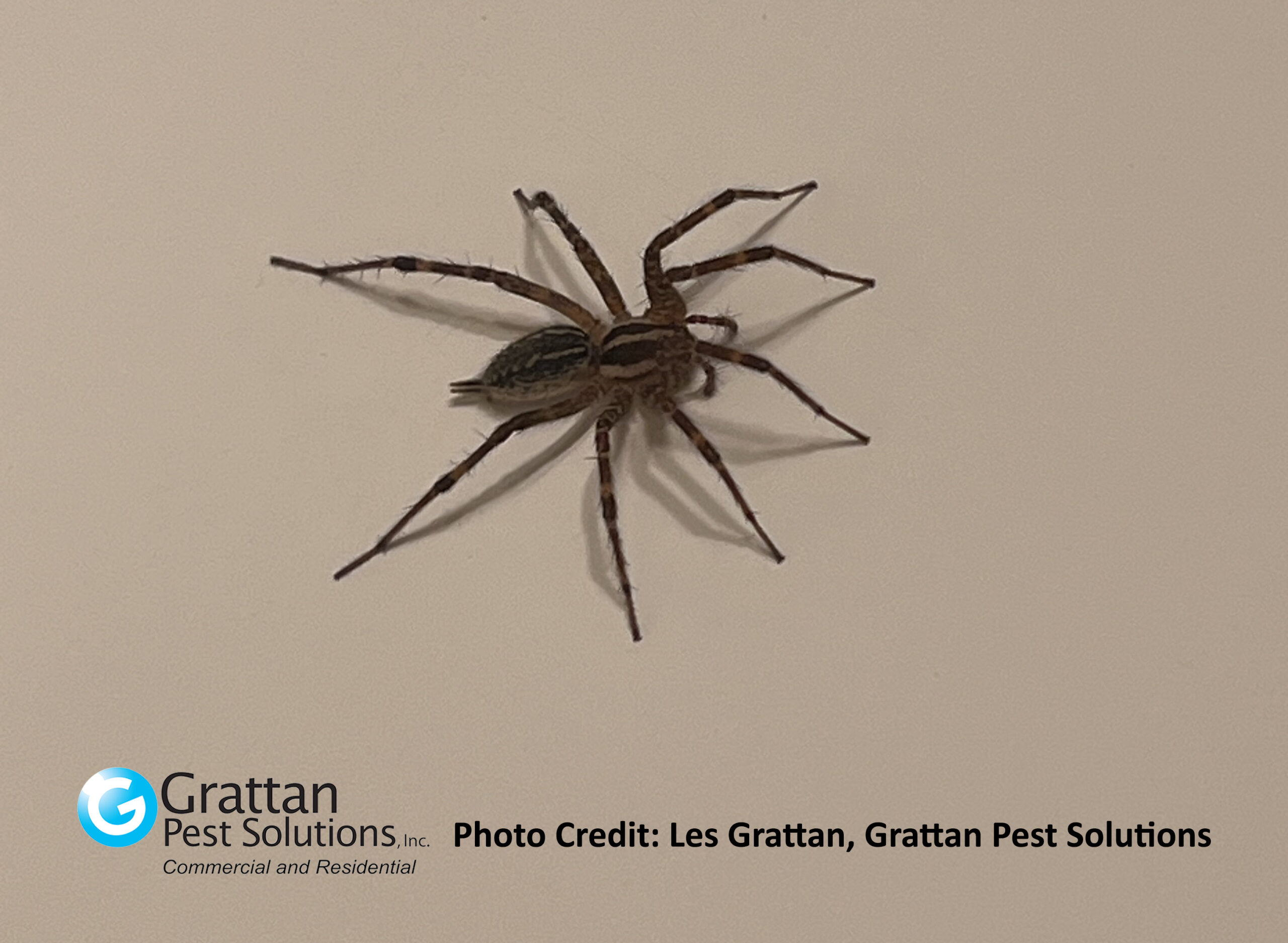
The Lycosidae, commonly called wolf spiders are a family of hunter spiders found throughout the United States and the rest of the world. A common species of the Wolf Spider is very similar to the common American Grass Spider or the Nursery Web Spider. They often do not have quite the same striping but the best way to tell them apart is by the eye pattern as described below.
The Wolf Spider is a hunting spider and will wander in search of its prey. They usually do not spin webs like most spiders do. Though they have the ability to, they often only do so to attach their eggs to their abdomen and carry them around. Once the babies hatch, they will continue to ride around on the mother’s back until they are large enough to fend for themselves.
The bite from a Wolf Spider can cause some pain, redness and swelling. In some cases, swollen Lymph glands may occur and the skin area at the bite can turn black. Swelling and Pain can last up to 10 days. Source: usaspiders.com

